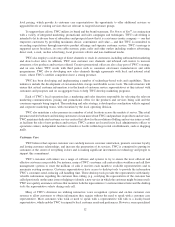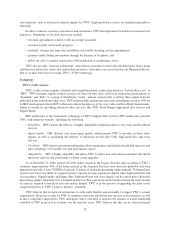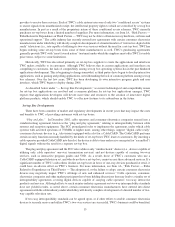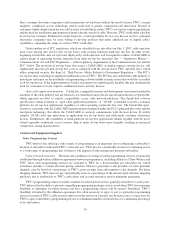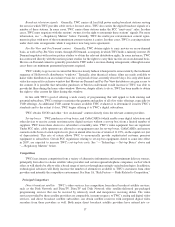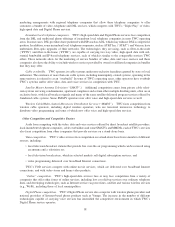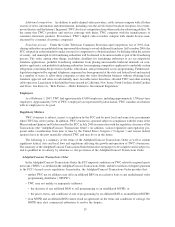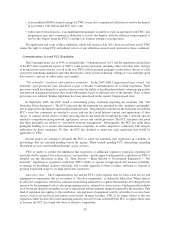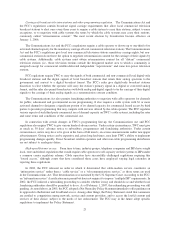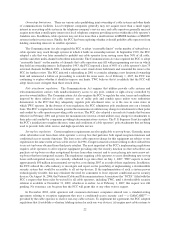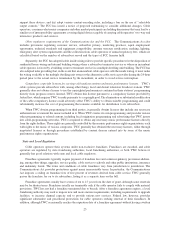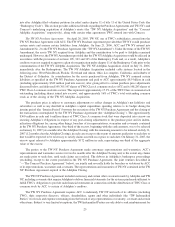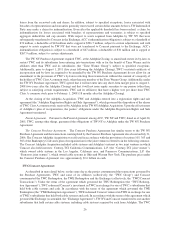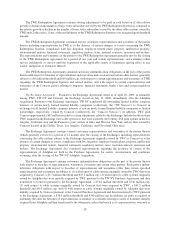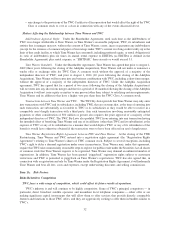Time Warner Cable 2006 Annual Report Download - page 27
Download and view the complete annual report
Please find page 27 of the 2006 Time Warner Cable annual report below. You can navigate through the pages in the report by either clicking on the pages listed below, or by using the keyword search tool below to find specific information within the annual report.Ownership limitations. There are various rules prohibiting joint ownership of cable systems and other kinds
of communications facilities. Local telephone companies generally may not acquire more than a small equity
interest in an existing cable system in the telephone company’s service area, and cable operators generally may not
acquire more than a small equity interest in a local telephone company providing service within the cable operator’s
franchise area. In addition, cable operators may not have more than a small interest in MMDS facilities or SMATV
systems in their service areas. Finally, the FCC has been exploring whether it should prohibit cable operators from
holding ownership interests in satellite operators.
The Communications Act also required the FCC to adopt “reasonable limits” on the number of subscribers a
cable operator may reach through systems in which it holds an ownership interest. In September 1993, the FCC
adopted a rule that was later amended to prohibit any cable operator from serving more than 30% of all cable,
satellite and other multi-channel subscribers nationwide. The Communications Act also required the FCC to adopt
“reasonable limits” on the number of channels that cable operators may fill with programming services in which
they hold an ownership interest. In September 1993, the FCC imposed a limit of 40% of a cable operator’s first 75
activated channels. In March 2001, a federal appeals court struck down both limits and remanded the issue to the
FCC for further review. The FCC initiated a rulemaking in 2001 to consider adopting a new horizontal ownership
limit and announced a follow-on proceeding to consider the issue anew. As of February 1, 2007, the FCC was
continuing to explore whether it should re-impose any limits. TWC believes that it is unlikely that the FCC will
adopt limits more stringent than those struck down.
Pole attachment regulation. The Communications Act requires that utilities provide cable systems and
telecommunications carriers with nondiscriminatory access to any pole, conduit or right-of-way controlled by
investor-owned utilities. The Communications Act also requires the FCC to regulate the rates, terms and conditions
imposed by these utilities for cable systems’ use of utility pole and conduit space unless state authorities
demonstrate to the FCC that they adequately regulate pole attachment rates, as is the case in some states in
which TWC operates. In the absence of state regulation, the FCC administers pole attachment rates on a formula
basis. The FCC’s original rate formula governs the maximum rate utilities may charge for attachments to their poles
and conduit by cable operators providing cable services. The FCC also adopted a second rate formula that became
effective in February 2001 and governs the maximum rate investor-owned utilities may charge for attachments to
their poles and conduit by companies providing telecommunications services. The U.S. Supreme Court has upheld
the FCC’s jurisdiction to regulate the rates, terms and conditions of cable operators’ pole attachments that are being
used to provide both cable service and high-speed data service.
Set-top box regulation. Certain regulatory requirements are also applicable to set-top boxes. Currently, many
cable subscribers rent from their cable operator a set-top box that performs both signal-reception functions and
conditional-access security functions. The lease rates cable operators charge for this equipment are subject to rate
regulation to the same extent as basic cable service. In 1996, Congress enacted a statute seeking to allow subscribers
to use set-top boxes obtained from third party retailers. The most important of the FCC’s implementing regulations
requires cable operators to offer separate equipment providing only the security function (so that subscribers can
purchase set-top boxes or other navigational devices from other sources) and to cease placing into service new set-
top boxes that have integrated security. The regulations requiring cable operators to cease distributing new set-top
boxes with integrated security are currently scheduled to go into effect on July 1, 2007. TWC expects to incur
approximately $50 million in incremental set-top box costs during 2007 as a result of these regulations. In addition,
the FCC ordered the cable industry to investigate and report on the possibility of implementing a downloadable
security system that would be accessible to all set-top devices. If the implementation of such a system proves
technologically feasible, this may eliminate the need for consumers to lease separate conditional-access security
devices. On August 16, 2006, the National Cable and Telecommunications Association (the “NCTA”) filed with the
FCC a request that these rules be waived for all cable operators, including TWC, until a downloadable security
solution is available or December 31, 2009, whichever is earlier. As of February 1, 2007, this request was still
pending. No assurance can be given that the FCC will grant this or any other waiver request.
In December 2002, cable operators and consumer-electronics companies entered into a standard-setting
agreement relating to reception equipment that uses a conditional-access security card — a CableCARD
TM
—
provided by the cable operator to receive one-way cable services. To implement the agreement, the FCC adopted
regulations that (i) establish a voluntary labeling system for such one-way devices; (ii) require most cable systems to
22


